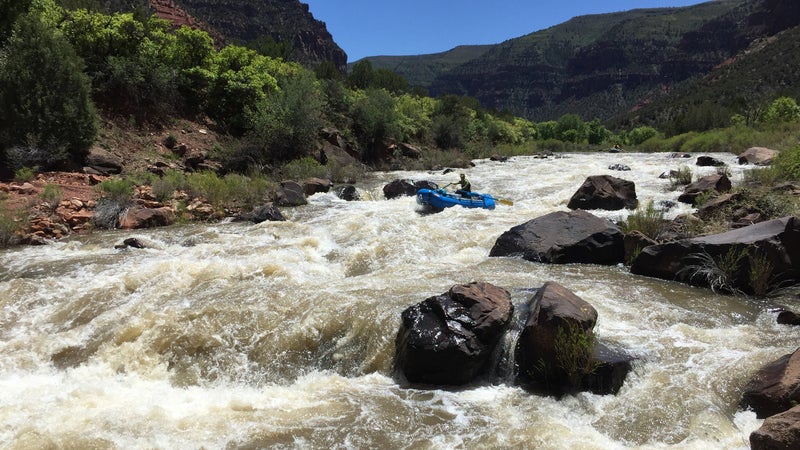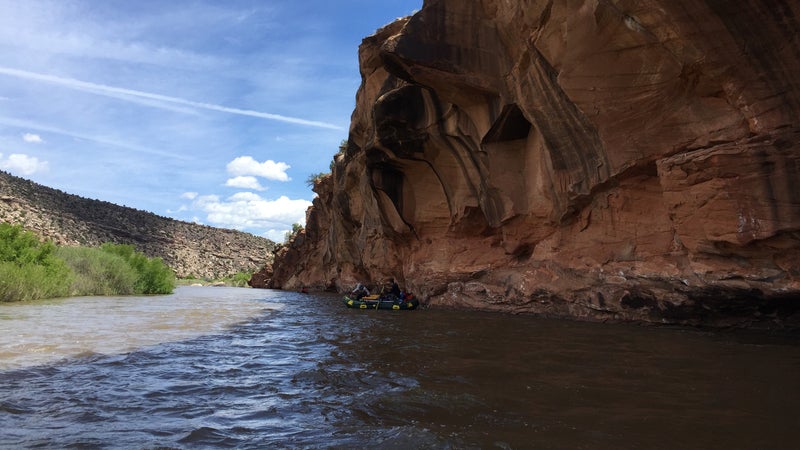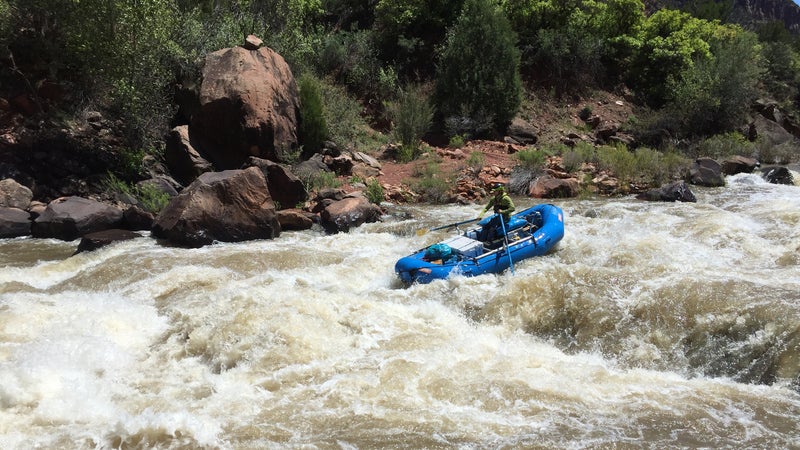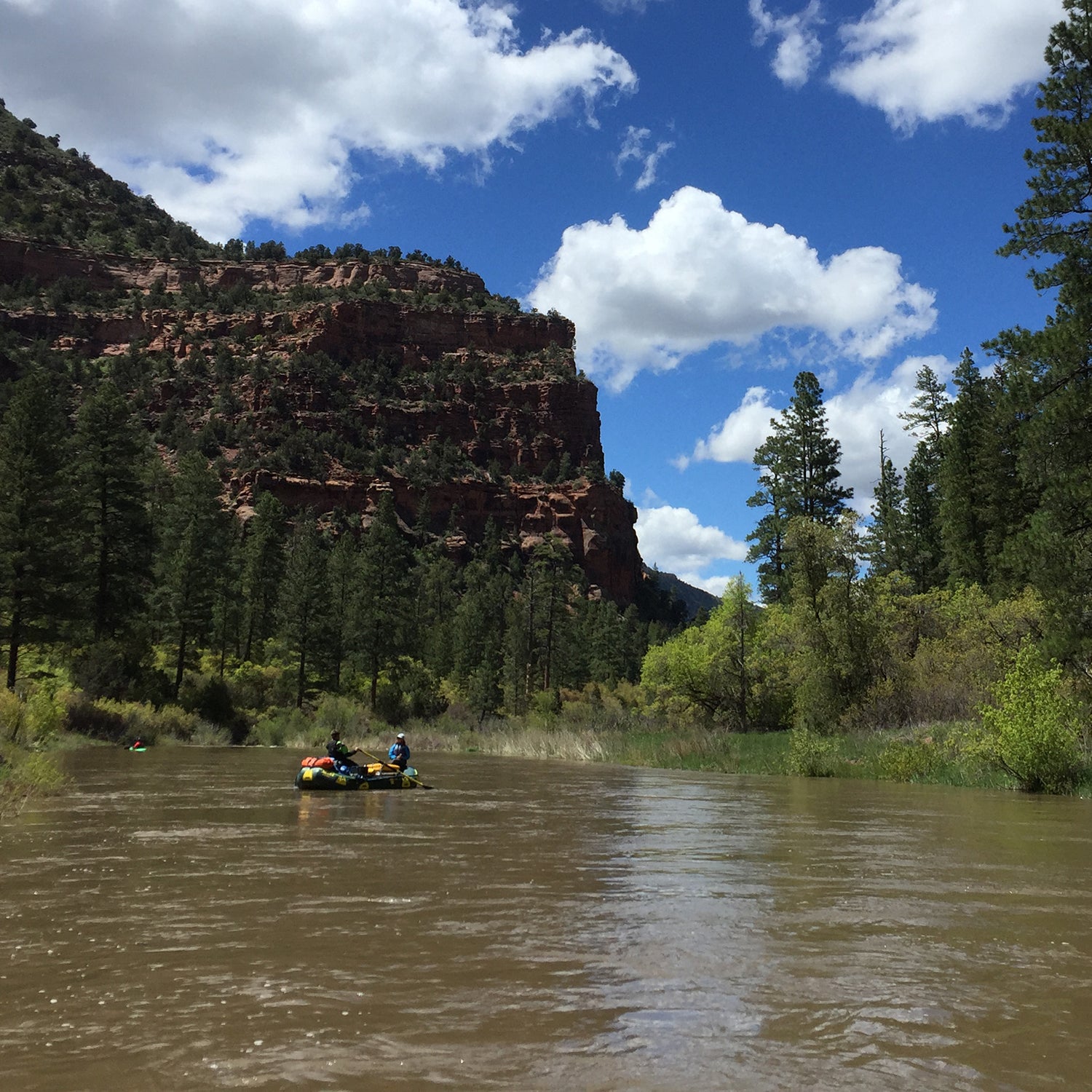The Dolores River╠řstarts in the high, ancient ponderosa forests on the southwestern edge of the San Juan Mountains before making╠řits way to the desert, cutting through 250 million years of geology, en route to╠řits meets up with the Colorado River. It has╠řone of the longest continuous raftable sections in the country, winding through one of the most beautiful, diverse canyons in the Southwest.
But it almost never runs.╠ř╠ř
Aside from a small section╠řset aside for fish habitat, nearly╠řall the water in the river is allocated for agriculture.╠řMcPhee Dam, about 60 miles northwest of the Four Corners,╠řholds the riverÔÇÖs water in the second-largest reservoir in Colorado. Its availability is mostly dependent on snowmelt, and it only spills enough for people to╠řfloat in it╠řevery three to five years, after irrigation needs have been met. Since 2000,╠řthe river has run at 1,200 cubic feet per second (cfs)ÔÇöthe recommended level for floatingÔÇöor more for only 131 days.╠ř
This was one of those good years. Snowpack in the river basin was at 302 percent of its normal level╠řin late May, and authorities planned to open╠řthe dam and╠ř╠řnear╠řthe end of the month.╠řI was at home╠řin Seattle when my friend Brad called on Tuesday, two days ahead of the╠řplanned release, to invite me on a trip down the river. ÔÇťWe put in on Friday, and you should come. You can just meet us at the put-in.ÔÇŁ
I was a 19-hour drive╠řaway, but IÔÇÖd been mythologizing those infrequent╠řreleases in in my head. I told him IÔÇÖd be there.
I rolled╠řinto the Bradfield Bridge parking lot, downstream from McPhee, after midnight on Friday. In the morning, five of us pulled╠řup to the ramp and started yanking boats off the trailer.╠ř

We pushed off╠řinto the swollen channel, which was choked with coyote willows that grow thick when the river doesnÔÇÖt run. Brad rowed one boat. Matt, another friend whoÔÇÖd been down for the last release two years ago, was at the oars of another, scouting for familiar landmarks.
The river was filled with groups ahead of us, commercial trips that had dusted off barely used permits. There were two boats of people in their eighties╠řfrom Oregon who planned to float all the way to Moab, Utah,╠řten╠řdays downstream, because they might never have the chance to do it again.
The DoloresÔÇÖs rare flows are the result of a complicated mesh of storage capacity, water rights, and a variable climate.╠řThe people who depend on the river are searching for a way to meet the needs of agriculture, conservation, and recreation while accounting for those factors. ItÔÇÖs a marker for the future in a hotter,╠řdrier Southwest.╠ř
The Dolores has been used for farming since 1889. Irrigation╠řbecame its primary purpose once the McPhee project was completed in 2000.╠ř
for McPhee Reservoir is 229,000 acre-feet. The average inflowÔÇöthe water that runs into the reservoir from snowmeltÔÇöis 327,000 acre-feet, of which 278,000 is╠řallocated for agriculture. That means McPhee is╠řessentially only big enough to serve agricultural rights. Because itÔÇÖs entirely╠řdependent on inflow, it doesnÔÇÖt have space to hold╠řextra water, so even in wet years, authorities canÔÇÖt bank any for recreation╠řor research. The reservoir can only spill the extra water for recreational flows╠řif thereÔÇÖs enough precipitation.
ÔÇťThe [Dolores Water╠řConservancy] DistrictÔÇÖs whole mission is to end the season with the reservoir at the tippy tippy top,ÔÇŁ says Jimbo Buickerood, lands and forest protection program manager of the , an environmental advocacy group focused on the San Juan Basin. He╠řfirst paddled the river in 1973.╠řÔÇťIt didnÔÇÖt end up full in 2017, and their board members freaked out.ÔÇŁ╠řFor the water district, which manages the dam, a full reservoir is a safety measure and a way to make sure all the legal needs are met, but it means thereÔÇÖs minimal flexibility for ecological and recreational flows, especially because the basin has been in drought for the past 20 years, Buickerood says.
ThatÔÇÖs particularly scary in years like 2018. The Dolores didnÔÇÖt run at all last year, leaving╠řpeople in the region haunted by the ghost of skimpy snowfall, the fear of threatened shortages, and not enough water to go around.
ÔÇťOur eyes were twitching because it was so freaky,ÔÇŁ says Sam Carter, the program and outreach coordinator for . ÔÇťAnd now, this year, thereÔÇÖs enough water to fill a reservoir that was at historic lows.ÔÇŁ Carter, who sits on the spill committee that helps decide how much water to release and when, says this year caught them off guard, and that theyÔÇÖre still nervous about last yearÔÇÖs drought. TheyÔÇÖre constantly at the mercy of the snowpack.

As we floated downstream,╠řred Wingate sandstone morphed into tan slabs of Navajo sandstone, Triassic ceding to Jurassic. Beavers popped their heads up in the eddies, and one night we set up the groover toilet next to fresh bear prints.╠ř
The campsites and banks were overgrown with plants like invasive tamarisk, which╠řgrows in shallow salty soil, because no one paddled through last season. That made it easy to picture╠řwhat it looks like when itÔÇÖs dry and the flood regime that supports native plans doesnÔÇÖt happen. You can see the human impact of a river channel with no water in it.╠řI wonder where the otters and beavers go when thereÔÇÖs only 40 cfs, the minimum fish flow, pulling through the channel. Buickerood says theyÔÇÖve discovered╠řthat cottonwood canÔÇÖt regenerate when the flows are low, and willows take over, armoring the banks.
The pinnacle of paddling on the Dolores is a rapid called Snaggletooth, a long, complicated series of moves where plenty could go wrong. It has a course of screw-you rocks at the top, then a narrow slide into a fast tongue of water╠řbetween a huge hole╠řand a ledgy pour-over. Below that, all the water pushes toward two hooked fangs of red rock, the teeth that give the rapid its name. We scouted for a while, watching other boats run through, trying to memorize the line, picking out plan A and plan B╠řin case we flipped or got╠řstuck in the hole╠řor surfed sideways in the pour-over. One of the boats of older folks heading to Moab pinned on a pancake rock while we looked on.
On shore, Matt told us it boated easier than it looked, which was a small consolation as we floated toward the horizon line and the river picked up speed. Brad was on the oars. We came in river right, skated over the rocks, and caught the current, slicing the edge of the hole,╠řjust sucking back for a second. Then we were free, and he was pushing downstream, toward the left bank, away from the toothy rocks, when I remembered to breathe again.╠ř
Scenery, Snaggletooth,╠řand solitude all coalesce to make the Dolores a prime destination for rafting, but ecological integrity is part of the puzzle, too. The two are linked, and Buickerood says that, in the face of drought, pressure to maintain the ecosystem might be the most powerful tool to keep water in the river for paddlers when inflows are reduced.╠ř
To try to account for that, and balance water rights with wildness, there have been a series of moves aimed at protecting╠řthe corridor. They range from a Wild and Scenic recommendation in 1968, after the dam was approved, to a more recent proposal to become╠řa national conservation area, which Carter says would only protect the landscape, not the water, because flows are still beholden to the irrigation water rights, even if the land is protected.
This year, even though the snowpack was high, runoff was slow, thanks to a cold spring. The spill committee was cautious about when to release water. Buickerood says a lot of those decisions have historically happened out of fear.

The , a stakeholder group started in the early 2000s, is trying to get more flows for fish and more flexibility. It╠řsets recommendations for how to use excess water (when there is any),╠řand Carter says it╠řbrings in all of the riverÔÇÖs constituents, from irrigators to stream ecologists, to try and╠řfigure out how to use the river for the most purposes. Endangered fish are a big lever, as is the desire to maintain and manage the river corridor, all of which take water.╠ř
This yearÔÇÖs levels were╠řabnormally high. By the time we got off the river, three days later, snowpack was at more than 1,000 percent of the average.╠řThatÔÇÖs what climate change isÔÇöinconsistencies in the systems we depend on. The future of the Dolores is a complex question:╠řHow do we plan for a variable future and avoid one where╠řdecreased flows potentially pit agriculture against environmental concerns or recreation?
ÔÇťMy answer to that╠řquestion is building relationships.╠řThe biggest piece is communication,ÔÇŁ Carter says.
As the Southwest dries outÔÇöand nearly ╠řthat it willÔÇöI donÔÇÖt want river trips to be freak pilgrimages that feel like last glances at a fragile, fading slice of a natural system we used to know. IÔÇÖm glad I came, IÔÇÖm glad I saw it, but I donÔÇÖt want this swollen water year to be the last time I do.


